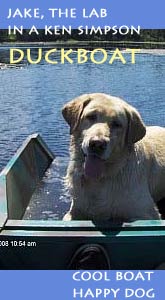Part One - Part Two
MirageDrive® Mechanical Experience
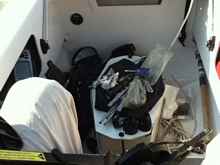 |
Bad Hobie day (only one of the trip). |
While the MirageDrive® is elegant in its simplicity, my unit started to show signs of wear around 500 miles in the form of slop in the pedal arms. This didn't affect function, but I found it annoying nonetheless. Surprisingly most of the wear appears to be of the aluminum shafts (see photo) and not the thermoplastic parts. The drum shaft can be tapped out of place, rotated a quarter turn and reinstalled to wear on a different side. The sprocket and idler pulley shafts are indexed, so they need to be replaced, which is easy to do. As a side note, I may have contributed to wear of the later two shafts by maintaining too much tension on the drive chains and idler cable in the first months of trial and error. Since that time I've been following on-line recommendation of allowing 3/16 in. of lateral motion (with application of finger pressures) for the aft sprocket chain and 1/8 in. of lateral motion for the forward sprocket chain and idler cable. No other parts have worn significantly in the 1,000+ miles I have on the system.
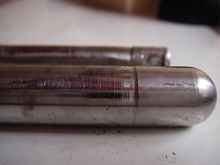 |
Wear to aluminum drum shaft (foreground) and idler pulley shaft. |
Trip maintenance on the MirageDrive® is negligible. An occasional application of spray lubricant to the sprocket chains and cables is about it. I do lightly grease the aluminum shafts when I overhaul the unit to avoid intermittent squeaking that I've experienced when the unit was "dry assembled". The steel fin masts are also coated to minimize salt water corrosion. Because of the grease, I pull the unit out when the boat is anchored in shallow water to avoid exposing the drive to the sand and silt that tends to accumulate in the pedal well overnight.
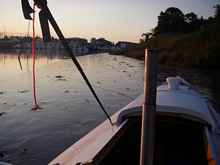 |
Another reason to remove the MirageDrive® when anchored for the night. |
With respect to on-the water failures, I've had four over the past 3+ years. Two instances were loss of the fin tension clevis pin after the lock ring managed to work itself out. Fortunately the fin did not slide off the mast and repair only took a few minutes, though it would have been a big problem without a spare ring and pin. Positioning the ring such that three stands of wire are through the pin hole (as shown in photo) has kept the ring from rotating and presumably will prevent a recurrence of this problem. The two remaining failures were a bit more serious.
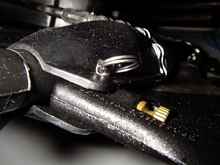 |
All three strands of the lock ring through clevis pin. |
Both failures involved the fin mast becoming disconnected from its base in the sprocket. In the first instance the base hole ovalized to the point that the fin mast would fall out every few hours operation. The second instance was a fatigue failure of the upper end of the mast itself, inside of the sprocket. The design features that caused these failures have been designed out of the current production (V2 configuration) sprocket which uses a threaded insert instead of an allen screw and notch for fin mast retention. The new design certainly looks more robust. Time will tell how effective these changes are, particularly with the long (Turbo ST) fins.
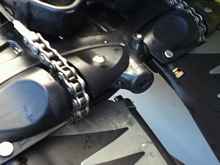 |
Fin mast failure at attachment to drive sprocket. |
Operation
Just making the boat go is a simple back and forth pedal motion, as distinct from the circular motion of pedaling a bicycle. Making the boat go well (or at least better), requires matching the fins to your cadence and fin tension setting to the prevailing conditions. Hobie® currently offers three types of fins for the MirageDrive®; the (most commonly) factory installed elliptical fin, the "ST" (square tip) fin and the "ST Turbo" (square tip with ~3 inch greater length).
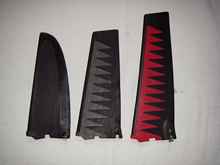 |
Left to right, Elliptical, ST and ST Turbo Fins. |
Some folks describe them as low, medium and high gear respectively. It is an appropriate metaphor in the sense that the pedal forces are lighter and you need to pedal at a higher cadence to get the same boat speed with smaller fins, but there is no gain in mechanical advantage. In my experience the maximum boat speed doesn't change measurably between the three fin sizes, perhaps because the drag rise at hull speed mutes the power differences. The lower pedaling cadence of the ST Turbo (long) fins does provide a significant improvement in sustained cruising speed, however. My loaded boat, daily moving average increased about a half knot to 3.7 knots, with less fatigue, when I switched from standard length ST fins.
The only performance adjustment on the MirageDrive® unit is fin tension on the ST fins. I don't have data, but my impression is that tightening the trailing edge makes the fins more effective at higher boat speeds. Around 3.5 to 4 knots pedal resistance seems to firm up and the fins seem to provide more thrust at a lower cadence. This is particularly apparent when sailing. A relatively small amount of pedaling effort yields significant jumps in boat speed under sail. It just feels like you're "in the groove". When boat speed drops toward three knots due to head wind or chop, the pedal pressure drops as if the tensioned fins are stalling or slipping in the water. With fin tension slackened, the pedal pressure stays uniformly low and the boat moves more slowly, but seems better able to maintain/regain that speed in the face of head winds or waves. Can't prove any of this, but it is just my impression.
Very little force is required to operate the unit with any fin size, particularly if the returning pedal is unloaded by pulling that leg back while pushing with the opposite. Varying the ratio of leg lifting and pushing also seems to improve endurance by providing a degree of muscle rest. Changing the length of pedal stroke also seems to provide some relief from muscle and joint soreness. Some users periodically change the pedal position to provide relief from soreness, but I've not found that helpful.
The web contains a wealth of information about MirageDrive® maintenance, tuning and use. A couple places that fill many of the information gaps in this article are:
Component Terminology
and Maintenance.
|




